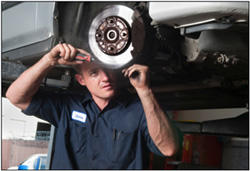Anti-lock braking systems (ABS) are designed to prevent skidding and enable you to keep steering control of your vehicle until you can stop safely. This system also often shortens the distance your vehicle takes to stop and can prevent the tire damage that would result if you had to stop with thewheels locked.
ABS comes in two types: two-wheel and four-wheel. Some light trucks and vans have a two-wheel anti-lock braking system on the rear wheels that maintains directional stability. Although the front wheels can still lock up, the vehicle continues to move in a straight line. With just enough pressure applied to the brake pedal, the driver can control the steering. You find four-wheel anti-lock braking systems on other light trucks and most cars.
These prevent all four wheels from locking up, which enables you to maintain steering ability in emergency stopping situations. If no impending lockupoccurs, the ABS stays in standby mode.
How ABS Works
Car Smarts: Here's how an anti-lock brake system operates: A microprocessor called an anti-lock brake computer monitors the speed of each wheel with an electronic component called a speed sensor. When you apply firm pressure to the brake pedal, the system triggers electronic solenoids to trap or release hydraulic pressure to each wheel independently, thousands of times faster than if you pumped the brake pedal as you would with ordinary brakes. You can usually hear this happening and feel the brake pedal pulsing when the system energizes. While the system is working, it's important to keep your foot pressed firmly on the pedal until the vehicle stops.
Remember: Do not pump your brake pedal if your vehicle has ABS. Instead, use firm pressure on the brake pedal, keep steering, and let the microprocessor do the work for you.
If the anti-lock system has a problem, a warning light on the dashboard comes on and normal braking without anti-lock takes over. So if your amber anti-lock light illuminates, remember that you still have normal brakes. Just pump them and steer in the proper direction as though you'd never heard of ABS. And be sure to get the ABS fixed as soon as possible!
What ABS Doesn't Do
Caution: ABS can't prevent all skids, nor does it always stop your vehicle in a shorter distance. Although ABS does help you maintain steering, your vehicle may not turn as quickly on a slippery road as it would on dry pavement. A combination of excessive speed, sharp turns, and slamming on the brakes can still throw an ABS-equipped vehicle into a skid. On roads covered with loose gravel or freshly fallen snow, the locked wheels of a vehicle without ABS can build up a wedge of gravel or snow and stop faster than an ABS-equipped vehicle. Therefore, it's important to keep a safe distance between your vehicle and the one in front of you and to try to maintain a constant speed ratherthan jamming on the brakes at the last minute.
Tip: When you drive a new vehicle with ABS, it's a good idea to know what the brakes feel like when they're operating normally. Find an empty parking lot on a rainy or snowy day and slam on the brakes, noticing how your vehicle responds. Keep your foot firmly on the pedal and get a feel for steering while the brakes operate. Then you'll know what to expect in a panicky situation.
From Auto Repair for Dummies, copyright © 2009 by Wiley Publishing, Inc., Indianapolis, Indiana. Used by arrangement with John Wiley & Sons, Inc.






